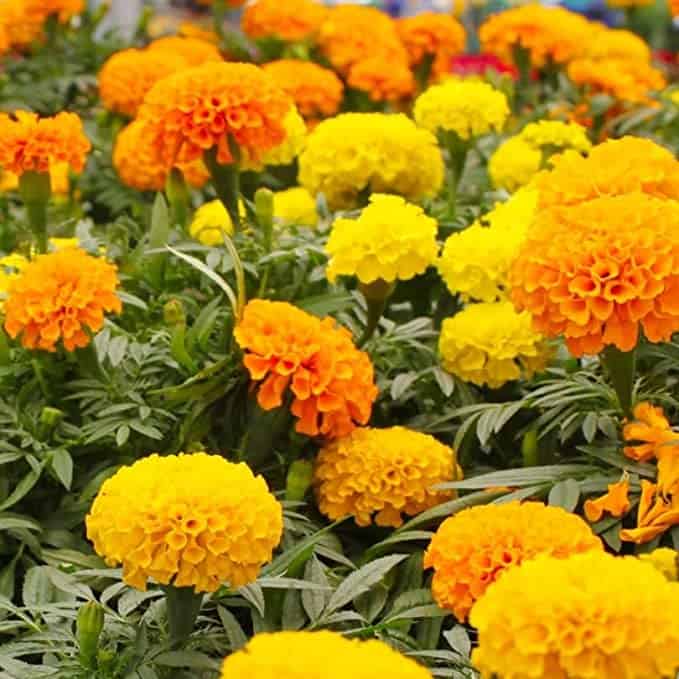Tagetes Erecta, sometimes known as the African Marigold, is a bushy annual prized for its large double flowers. Commonly associated with the color orange, these flowers also come in yellow, white, and red shades. Each blossom measures two to four inches across and will bloom from early summer until the first frost. The name Tagetes is derived from the planet Mars, which was thought to be the deity of fertility, while “erecta” means upright or erect.
These plants are very versatile, and they need minimal assistance to thrive. They are often used in beds and borders, as well as in patio pots, window boxes, and cottage gardens. They attract beneficial insects that help balance the ecosystem and can be used to repel insect pests.
Family
Tagetes Erecta is a member of the Asteraceae family.
Plant Type
Tagetes Erecta is an annual flower.
Mature Size
African marigolds will grow up to 24 inches tall.
Sun Exposure
These flowers prefer full sun to partial shade.
Although the plant that requires full sun exposure to grow and thrive. It is important to ensure that the plant receives at least 6-8 hours of direct sunlight every day.
If the plant is not receiving enough sunlight, it may become leggy and fail to produce abundant blooms. On the other hand, if the plant is exposed to too much sun without adequate water, it may become wilted and stressed.
Soil type
Tagetes erecta grows best in a well-draining, slightly acidic soil with a pH of 6.0 to 6.7.
Soil pH
The soil needs to have a pH of 6.0 to 6.7.
Bloom Time
African marigolds typically bloom from early summer until the first frost.
Flower Color
The flowers come in a variety of shades, including yellow, red, orange, and white.
Hardiness Zones
Tagetes erecta can be grown in USDA hardiness zones 4-11.
Native Area
The African Marigold is native to the hot, dry climates of Mexico and Central America.
How to Plant
When planting African marigolds, choose an area of your garden that is exposed to full sun and has well-draining soil with a slightly acidic pH. Plant the seeds 1/4 inch deep, spaced 10-12 inches apart. African Marigolds prefer cooler soil temperatures so it is best to wait until spring to plant them. Water the soil to keep the seeds moist. As the plants grow, water them weekly and fertilize them when necessary. Deadhead the spent blooms to promote re-blooming.
Meaning and Symbolism
The African Marigold is often associated with passion and creativity. The Spanish name for the Tagetes erecta is “Flor de Muerte” which means “Flower of Death”. In Holland, the African Marigold is the flower of sympathy indicating that the wearer is in mourning. This flower is also seen as a symbol of the sun and used to represent many themes such as victory, friendship and prosperity. Additionally, African Marigolds are often used to celebrate a new life and symbolize wealth, health, friendship and good luck.
History, Mythology, and Religious Significance
The African Marigold is one of the oldest flowering court plants, known to have been cultivated as early as 500 BC for medicinal as well as ceremonial purposes. It has been used to treat many ailments such as fever, skin diseases and indigestion. Ancient Aztec, Mayan and Incan cultures used the extract of this flower, added to food and drinks, to protect the body from the sun’s rays. In India, Hindu mythology states that if an African Marigold was placed over the entrance of a house, it warded off evil spirits.
Flower Varieties and Their Defining Characteristics
Tagetes erecta comes in many different varieties. Some of the most popular varieties are Burgundy Giant, Disco Gold, Lemon Bronze, and Sunburst Mix. The Burgundy Giant variety has wine-red bicolor blooms and grows about 20 inches tall. The petals of the Disco Gold variety are deep orange with darker throats. The Lemon Bronze variety produces yellow petals with lemon centers and grows about 12 inches tall. Lastly, the Sunburst Mix variety has golden-yellow flowers and grows about 24 inches tall.
Buy African Marigolds on Amazon>>
How to Pot and Repot
For potting an African Marigold, select a containers that has adequate drainage holes at the bottom. Make sure to use a well-draining potting mix. If planting multiple plants in one container, space them 10-12 inches apart. Fill the container with soil and place the plants into the soil. Gently firm the soil around the plants and water the soil deeply. When repotting, use a larger container with more potting mix. Remove the old soil and place the plant into the new container, then fill the container with potting mix. Water the soil deeply.
How to Prune
African Marigolds can be pruned to maintain an attractive shape or to prevent them from becoming leggy or overcrowded. Prune by pinching off the top of the plant. This will encourage side shoots and fuller foliage. For best results, deadhead the blooms regularly to promote re-blooming. Be careful not to prune too much, as African Marigolds will not bloom as heavily if the branches are pruned too much.
How to Propagate
African Marigolds can be propagated by seed, through division or through stem cutting. To propagate by seed, prepare the seeds prior to planting in potting mix or in the ground. Allow the soil to dry completely before watering. If propagating through division, create divisions in the spring or fall when the plants have become overcrowded. Allow the divisions to dry for a few days before replanting. To propagate through stem cutting, snip a 4- to 6-inch long stem from the parent plant. Remove the lower leaves and place the cutting in a glass of water or a container with moist sand. Change the water daily until the cutting has rooted. When ready, plant the cutting into a potting mix or in a garden bed.
Common Pests and Diseases
Common pests and diseases of African Marigolds include aphids, beetle damage, root rot, and gray mold. Constant vigilance should be kept to ensure that you catch potential problems early on. To prevent pest and disease problems, keep the garden clean and tidy, deadhead spent flowers and remove any damaged plants. Prune the plants to increase air circulation and apply an insecticidal soap or fungicide if needed.
Frequently Asked Questions
Q1. Where does the African Marigold grow best?
A1. African Marigolds grow best in full sun, with well-draining soil and a slightly acidic pH.
Q2. When is the best time to plant African Marigolds?
A2. African Marigolds should be planted when the soil temperature is between 55-65 degrees Fahrenheit.
Q3. How long does it take for African Marigolds to bloom?
A3. African Marigolds will typically start to bloom in 3-4 weeks and will bloom until the first frost.
Table Fact Sheet
| African Marigold | Tagetes erecta |
| Family | Asteraceae |
| Plant Type | Annual |
| Mature Size | Up to 24 inches |
| Sun Exposure | Full sun to partial shade |
| Soil Type | Well-draining, slightly acidic |
| Soil pH | 6.0 to 6.7 |
| Bloom Time | Early summer to first frost |
| Flower Color | Yellow, Red, Orange, White |
| Hardiness Zones | 4-11 |
| Native Area | Mexico and Central America |
What we love from Amazon this week
Buy these wonderful flowers directly from Amazon:
















